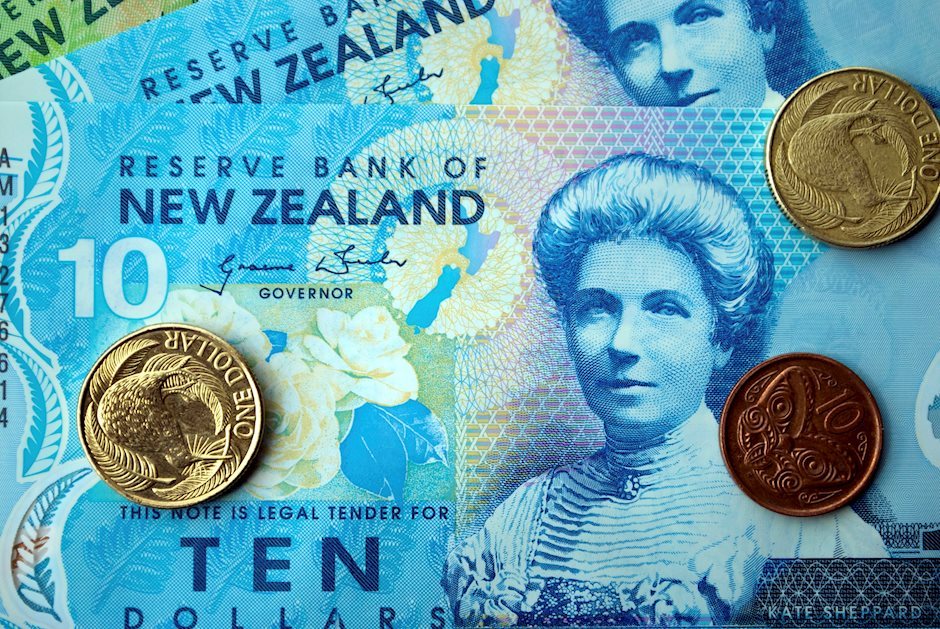NZD/USD retakes 0.6100 mark amid weaker USD, upside potential seems limited
- NZD/USD draws support from a modest US weakness and a positive risk tone.
- Fed rate cut uncertainty should limit the USD losses and cap gains for the pair.
- China’s economic woes further warrant caution for aggressive bullish traders.

The NZD/USD pair attracts some dip-buying during the Asian session on Monday and looks to build on Friday's modest bounce from the vicinity of mid-0.6000s, or its lowest level since mid-May touched on Friday. Spot prices currently trade around the 0.6100 mark amid a modest US Dollar (USD) weakness, though lack bullish conviction amid the uncertainty over the Federal Reserve's (Fed) rate-cut path.
The US Personal Consumption Expenditures (PCE) Price Index released on Friday confirmed the disinflationary trend as shown by the Consumer Price Index (CPI) and Producer Price Index (PPI) for May. The data reaffirmed market bets that the Fed will start cutting interest rates at the September policy meeting, which keeps the USD bulls on the defensive. Apart from this, a positive tone around the US equity futures undermines the safe-haven buck and lends support to the NZD/USD pair.
That said, the Fed adopted a more hawkish stance at the end of the June policy meeting and forecasted only one interest rate cut in 2024. Furthermore, President Joe Biden's disastrous debate with his Republican opponent increased the odds of a Trump presidency. This, in turn, fueled worries that the imposition of aggressive tariffs by the Trump administration could fuel inflation and trigger higher rates, which remains supportive of elevated US Treasury bond yields and should limit the USD losses.
Adding to this, expectations that the Reserve Bank of New Zealand (RBNZ) will cut rates earlier than projected and China's economic woes might hold back bullish traders from placing fresh bets around the NZD/USD pair. In fact, official data released on Sunday showed that China's manufacturing activity fell for a second month in June while services activity slipped to a five-month low. This, in turn, warrants some caution before confirming that spot prices have formed a near-term bottom.
Moving ahead, traders now look forward to important US macro releases scheduled at the start of a new month, starting with the ISM Manufacturing PMI, for short-term opportunities later during the North American session. The focus, however, will remain glued to the closely-watched US monthly employment details, popularly known as the Nonfarm Payrolls (NFP) report on Friday. The latter will play a key role in influencing the near-term USD price dynamics and driving the NZD/USD pair.
US Dollar FAQs
The US Dollar (USD) is the official currency of the United States of America, and the ‘de facto’ currency of a significant number of other countries where it is found in circulation alongside local notes. It is the most heavily traded currency in the world, accounting for over 88% of all global foreign exchange turnover, or an average of $6.6 trillion in transactions per day, according to data from 2022. Following the second world war, the USD took over from the British Pound as the world’s reserve currency. For most of its history, the US Dollar was backed by Gold, until the Bretton Woods Agreement in 1971 when the Gold Standard went away.
The most important single factor impacting on the value of the US Dollar is monetary policy, which is shaped by the Federal Reserve (Fed). The Fed has two mandates: to achieve price stability (control inflation) and foster full employment. Its primary tool to achieve these two goals is by adjusting interest rates. When prices are rising too quickly and inflation is above the Fed’s 2% target, the Fed will raise rates, which helps the USD value. When inflation falls below 2% or the Unemployment Rate is too high, the Fed may lower interest rates, which weighs on the Greenback.
In extreme situations, the Federal Reserve can also print more Dollars and enact quantitative easing (QE). QE is the process by which the Fed substantially increases the flow of credit in a stuck financial system. It is a non-standard policy measure used when credit has dried up because banks will not lend to each other (out of the fear of counterparty default). It is a last resort when simply lowering interest rates is unlikely to achieve the necessary result. It was the Fed’s weapon of choice to combat the credit crunch that occurred during the Great Financial Crisis in 2008. It involves the Fed printing more Dollars and using them to buy US government bonds predominantly from financial institutions. QE usually leads to a weaker US Dollar.
Quantitative tightening (QT) is the reverse process whereby the Federal Reserve stops buying bonds from financial institutions and does not reinvest the principal from the bonds it holds maturing in new purchases. It is usually positive for the US Dollar.
Author

Haresh Menghani
FXStreet
Haresh Menghani is a detail-oriented professional with 10+ years of extensive experience in analysing the global financial markets.

















